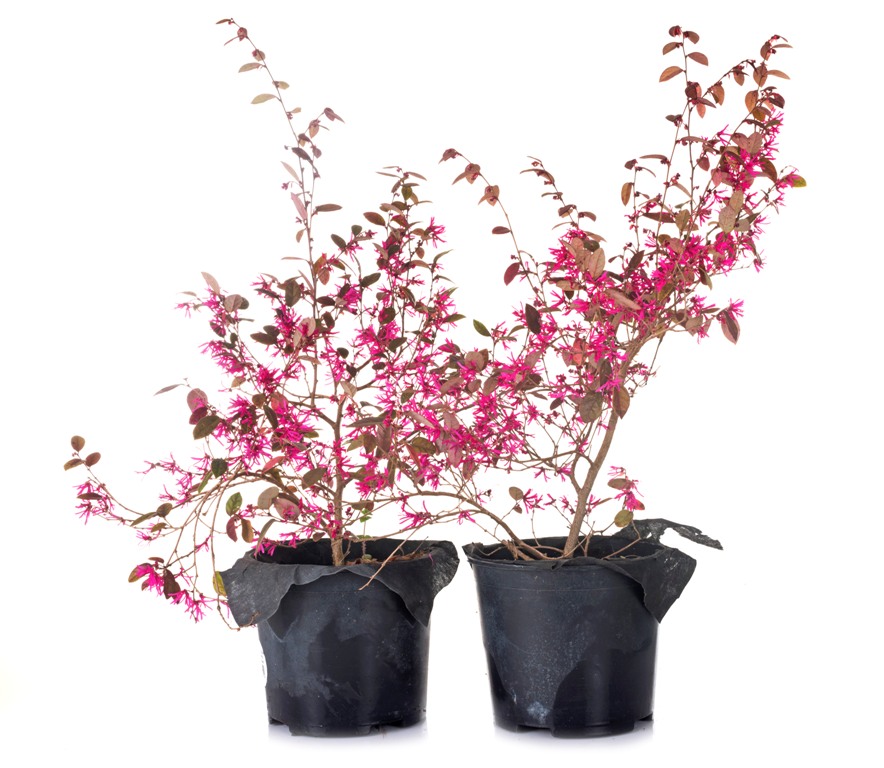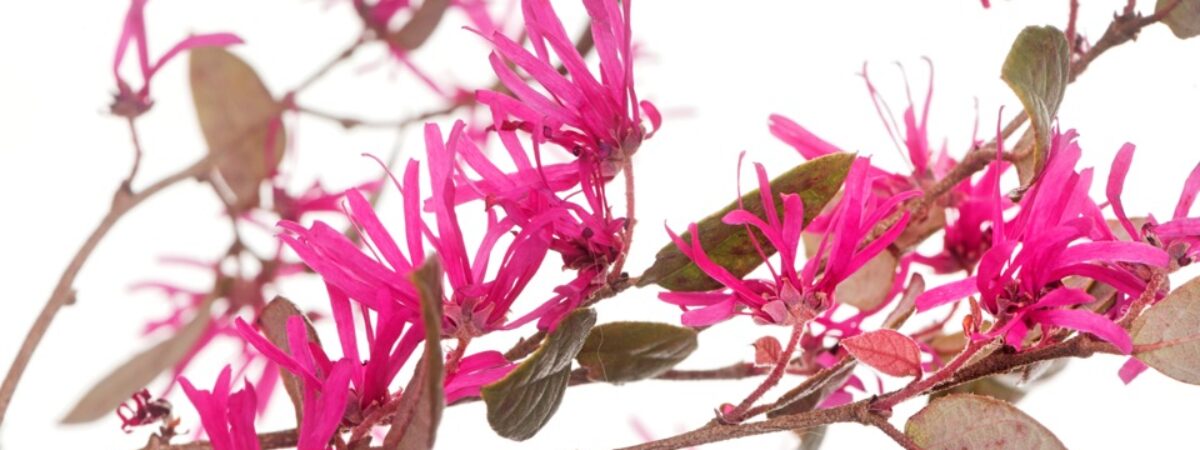Chinese Fringe is scientifically known as Loropetalum chinense. Chinese Fringe has other common names such as loropetalum, strap flower. It is an evergreen shrub that grows maximum up to 15 inches tall.
Chinese fringe flowers are perennial bushes that bloom in the spring and are recognized for their soft, fragrant blossoms.
Besides their beautiful blossoms, Chinese fringe blooms have interesting leaves that change colors throughout the year, from crimson to deep green.
These colorful shrubs, which are native to China, Japan, and the Himalayas, have become increasingly popular because of their year-round beauty and convenience of care.
Chinese fringe blossoms are also excellent protection bushes that can be utilized as hedging or topiaries. Click To TweetChinese fringe blossoms are also excellent protection bushes that can be utilized as hedging or topiaries.
Chinese fringe flower is a plant that is often neglected in tropical conditions. Like it’s winter-blooming sibling, this witch hazel relative has delicately creased green leaves and prolific bunches of gently fragrant, spidery flowers.
Many of the cultivars feature rich purple or burgundy foliage, which is unusual in perennial bushes. Its multilayer spreading behavior is yet another appealing characteristic.
It has a plethora of lovely, ruffled pink flowers that are very spectacular. It is indeed sad they’re only good for a few weeks. They do, however, live on in a lovely pink blanket on the earth where they fall for a bit longer.
The vibrant red tones of emerging spring vegetative growth are quite appealing. The foliage can be dark green to a rich plum during other seasons of the year, with several colors on a single branch.
It’s widely thought to be hardy in zones 8-10, while some growers have had success planting it as far north as zone 7.
Varieties
Chinese fringe blossoms come in a variety of colors and shapes. Among the most popular kinds are:
- Loropetalum chinense ‘Rubrum’
- Loropetalum chinense ‘Pizazz’
- Loropetalum chinense var. Rubrum ‘Burgundy’
- Loropetalum chinense ‘Carolina Moonlight’
- Loropetalum chinense ‘Snow Dance’
- Loropetalum chinense ‘Emerald Snow’
Growing Guide
To avoid being shocked by excessive temperature extremes, sow during the gentler seasons of spring or fall. In a pot or garden, plant in a sunlit to gently shaded location. In bright sunlight, plants will bloom and maintain their color the best.
Make any necessary amendments to the cultivated area with manure or other rich organic materials, ensuring that the soil is porous and well-draining.
Drill a trench that is 2 to 3 times the size of the root system and somewhat narrower.If indeed the roots sphere is pot bound, pull out surrounding roots or cut the root ball in many locations.
Arrange the root system in the sowing hole so that its tip is level with or somewhat above the soil surface.
Fill that void with topsoil, firmly press down to release trapped air, and irrigate thoroughly. Persist to irrigate once or twice a week until the roots are set. The distance is determined by the cultivar.

Caring Guide
Chinese fringe blossoms are resilient bushes that require little attention. These witch-hazel bush cousins can withstand a vast spectrum of light, soil, and moist environments.
Although Chinese fringe blooms are not particularly vulnerable to pests or diseases, they can succumb to typical pests like spider mites and diseases like anthracnose, mildew, and root rot.
Chinese fringe blossoms around the middle of the springtime, although good bushes can rebloom at any time during the planting season. In warmer regions, this shrub is evergreen, while in colder climates, it is regarded as a perennial.
Chinese Fringe is a drought-resistant plant. In fact, they frequently go days without a water supply. This plant can withstand almost any form of pruning. Click To TweetChinese Fringe is a drought-resistant plant. In fact, they frequently go days without a water supply. This plant can withstand almost any form of pruning.
Many growers trim them into bushes and even fences, while others allow these to mature into trees.
There is no need to fertilize the fringes, but if they appear to be in need of some treatment, use a 16-4-8 blend before the spring blooming surge. A covering of mulch is also beneficial to them.
Light
Plant Chinese fringe blooms in a warm, sunny spot that gets some shelter during the day. These bushes should be shielded from harsh afternoon heat yet enjoy the dappled morning light. They may, however, grow in sun to part shade situations.
Sun
Chinese fringe blooms demand acidic, well-draining soil with enough organic matter. It’s excellent if the soil pH is between 4.5 and 6.5. Mulch around the root ball of a Chinese fringe bloom bush using 2-3 inches of manure, straw, or seasoned forest residues to help preserve water and prevent weeds.
Water
Chinese fringe flowers are resistant to drought once they’ve set themselves. They do, however, thrive when the earth is continually wet. Chinese fringe flowers must be irrigated more often during periods of high temperatures or unusually long dry seasons.
Temperature and Humidity
Chinese fringe blooms thrive in USDA zones 7 to 9, where they can withstand freezing temperatures as Zero degrees Fahrenheit in the wintertime (-17.8 degrees Celsius).
Chinese fringe blooms, on the other hand, should be placed in settings that shield plants from cold winter breezes in countries where they have cold weather.

Fertilizer
Once developed, Chinese fringe flowers need almost no supplementary fertilizer if they are sown in the proper conditions.
If necessary, plants can be fertilized annually in springtime with a slow-release, all-purpose fertilizer – or one developed specifically for shrubs.
Chinese fringe blooms grown on nutrient-deficient soil, on the other hand, will require supplementary feeding.
Add organic matter to the soil on a routine basis, such as compost, grass and leaf clippings, and manure (composted).
Pruning
Several growers use these shrubs for fencing or topiaries because they can resist pruning. Chinese fringe flowers, on the other hand, do not need to be pruned, and they grow into a conventionally gorgeous shape that many people like.
Because the blooms of this resilient shrub grow on old wood, it’s preferable to prune Chinese fringe blooms after the flowering season in the summertime or early autumn.
Propagation
Softwood cuttings can be used to cultivate Chinese fringe flowers. Trim the foliage around the bottom half of the stem from a 6-inch cutting of fresh growth softwood.
Immerse the cutting’s base into a potting medium — 0.1 to 0.3 percent should be enough. Make a half-and-half combination of peat and perlite in a clean container featuring holes in the bottom. Make holes in the mud and stick the cutter through it.
Wrap the cutting with a plastic dome or a plastic bag that does not come into contact with the cutting. Maintain wet but not damp soil. Place the pot in a location where it will receive partial sunshine.
In 4 to 6 weeks, your shrub will develop a good set of roots. Based on your environment, leave the shrub in its pot till another planting time. After that, grow it in the yard.
Problems
Loropetalum is resistant to most pests and diseases. Root rot can be a problem, particularly in wet conditions, so ensure your plants are in a well-draining medium.
Galls may appear on the stems of these shrubs, and these cysts are caused by the prevalence of Pseudomonas savastanoi bacteria. Whenever you see these while purchasing, avoid buying the shrub.
Remove the branch several inches above the gall, discard the grass cuttings, and clean your trimmers if you discover them on mature plants in your garden.
Conclusion
This shrub is a rapidly growing , beautiful addition to many gardens. It is easy to handle and attractive.
They usually don’t need any extra water, fertilizer, insect control, or trimming, and they’re pruned rather hard. Despite this, they pay you with lush foliage and a spectacular spring show.
Try growing Chinese Fringe in your backyard and enjoy the beauty of the plant.
You may also like to read
A Best Guide on Growing and Caring of Lemongrass Plants
How to Grow Colorful Celosia Plants in your garden- A complete Guide







One thought on “How to grow Chinese Fringe Flowers in your Garden?- Everything you need to know Loropetalum”
Where I will get plant/seeds in Guwahati,Assam